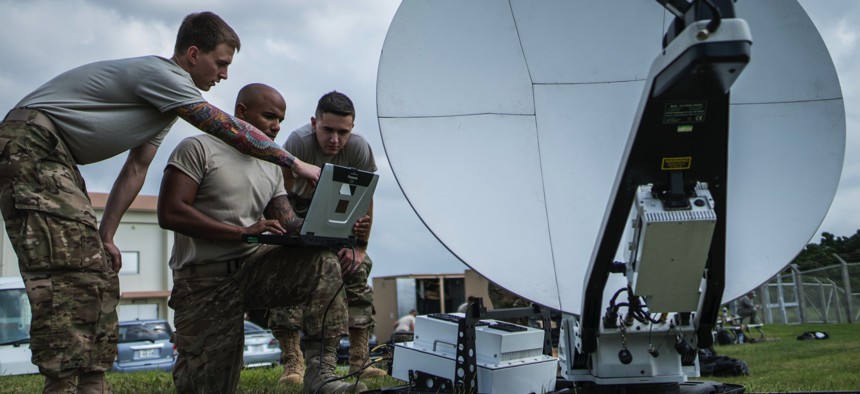
In this 2017 photo, U.S. Air Force communications technicians establish network connectivity for the Air Force Special Operations Command Air Rapid Response Kit (ARRK) at Kadena Air Base, Japan. U.S. Air Force / Capt. Jessica Tait
How the Air Force Is Preparing for Good and Bad Comms in the Pacific
The service’s top lab is also working on commercial cloud offerings and facilitating classified software development.
Should a war with China break out, the Air Force wants its intelligence community to be able to operate with full connectivity, no connectivity, and everything in between. For a service aggressively moving toward cloud services, this is no mean feat.
“The public cloud offers great services as long as you have connectivity. If you're disconnected, how do you still function and do what you need to do during that time frame?” said Norman Leach, a director in the Air Force Research Laboratory’s information directorate. “You need to be able to get stuff through with those higher latencies and lower network comms.”
Part of the answer is multiple communications pathways, such as hotspots or satellite communications options, said Leach, who is the Air Force’s director for Cloudworks and program manager for Operational DevSecOps for the Intelligence, Surveillance and Reconnaissance NEXGEN project.
Ultimately, he said, the Air Force wants to have “as much redundancy as possible” while planning how to complete the mission with degraded or missing connectivity.
The lab is also helping program offices develop classified software, at various levels, to code more efficiently and continuously deploy in minutes, Leach said. So far this year, the lab has helped put 40 systems into production, including some for data analysis, artificial intelligence, machine learning, as well as workflow systems.
“We're deploying capability into the public cloud and classified environments to enable folks to get stuff into production as quickly as possible,” Leach said, with enterprise security services, platforms, pipelines, and software-as-a-service tools.
AFRL frequently works with the service’s Platform One, Cloud One, and Mission Modernization Office, and with Pacific Air Forces. The lab is also working with the 33rd Network Warfare Squadron “to become the cloud cyber service security provider for the Air Force,” Leach said.
But the push to the cloud isn’t without challenges. Leach said. Besides getting systems accredited, there’s also training and educating security and software professionals about the environment, DevSecOps, and the processes that secure applications.
Leach said the lab is considering customers’ requests for more security and data transfer capabilities.
One is a classified code repository or system where commercial applications can be contained, added, secured, and deployed in a single environment. That would create a secure space for agencies or commercial vendors to store code that they don’t want “out on the public Internet, but are okay with enabling it to be available in a secured environment” with tools in place to support that. The other is for cross-domain mission data transfer that allows analysts to move information between different classification levels in cloud services.
“There's a bunch of tools out there on-prem, but getting something in place in the cloud that can be natively used, is what we've been asked to work with Amazon and Microsoft to put in place,” he said.
But edge capability is still the top priority, Leach said, with a plan to deploy devices for research and development by the end of this year.
“So really looking forward to working with our partners out here at PACAF and other theaters and getting that built up and deployed with them,” he said. “Definitely looking for feedback on what the needs are and what the pain points are here in the Pacific Theater to make sure that I have a full picture as we lead the team to deploy these capabilities.”




